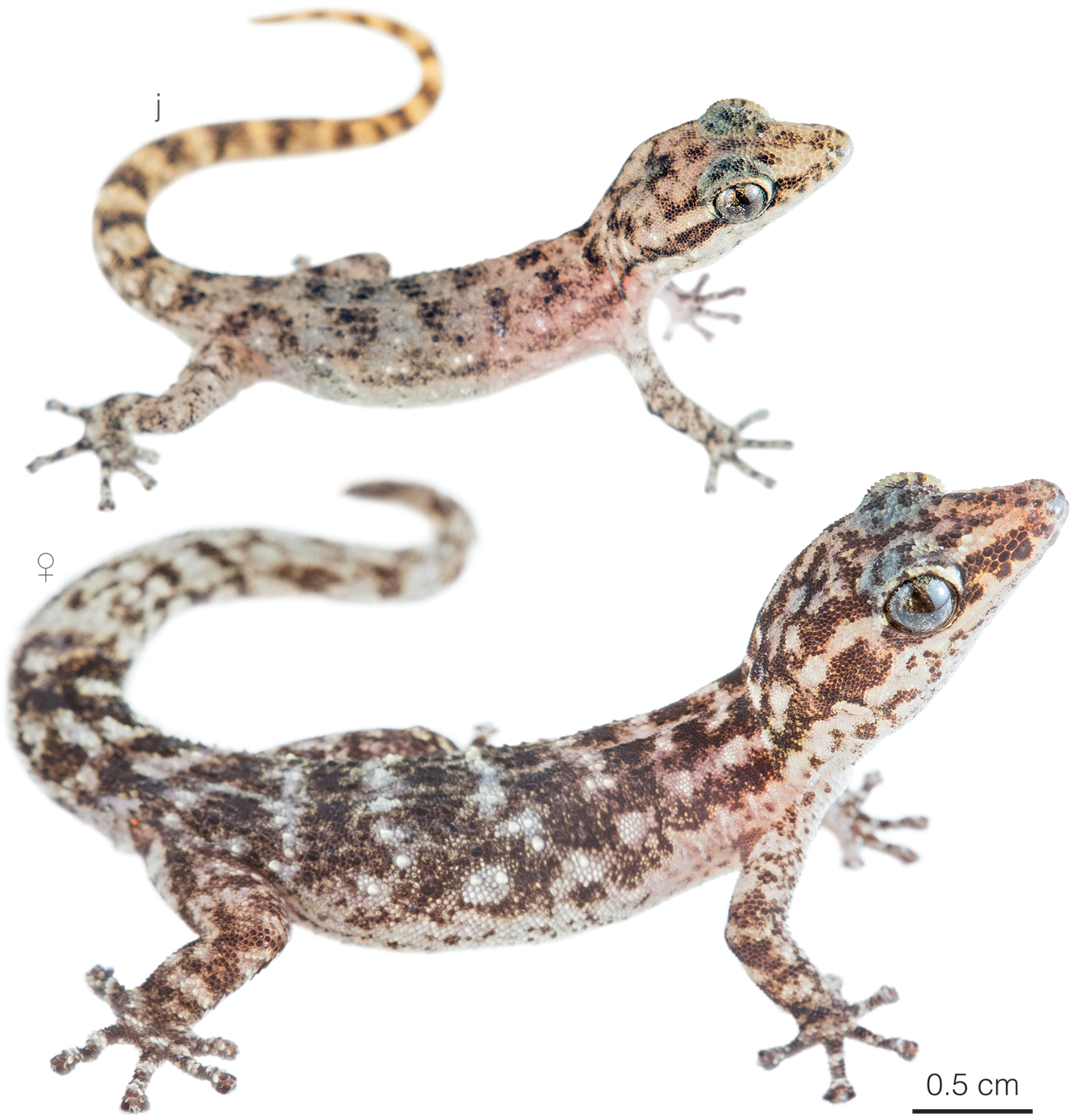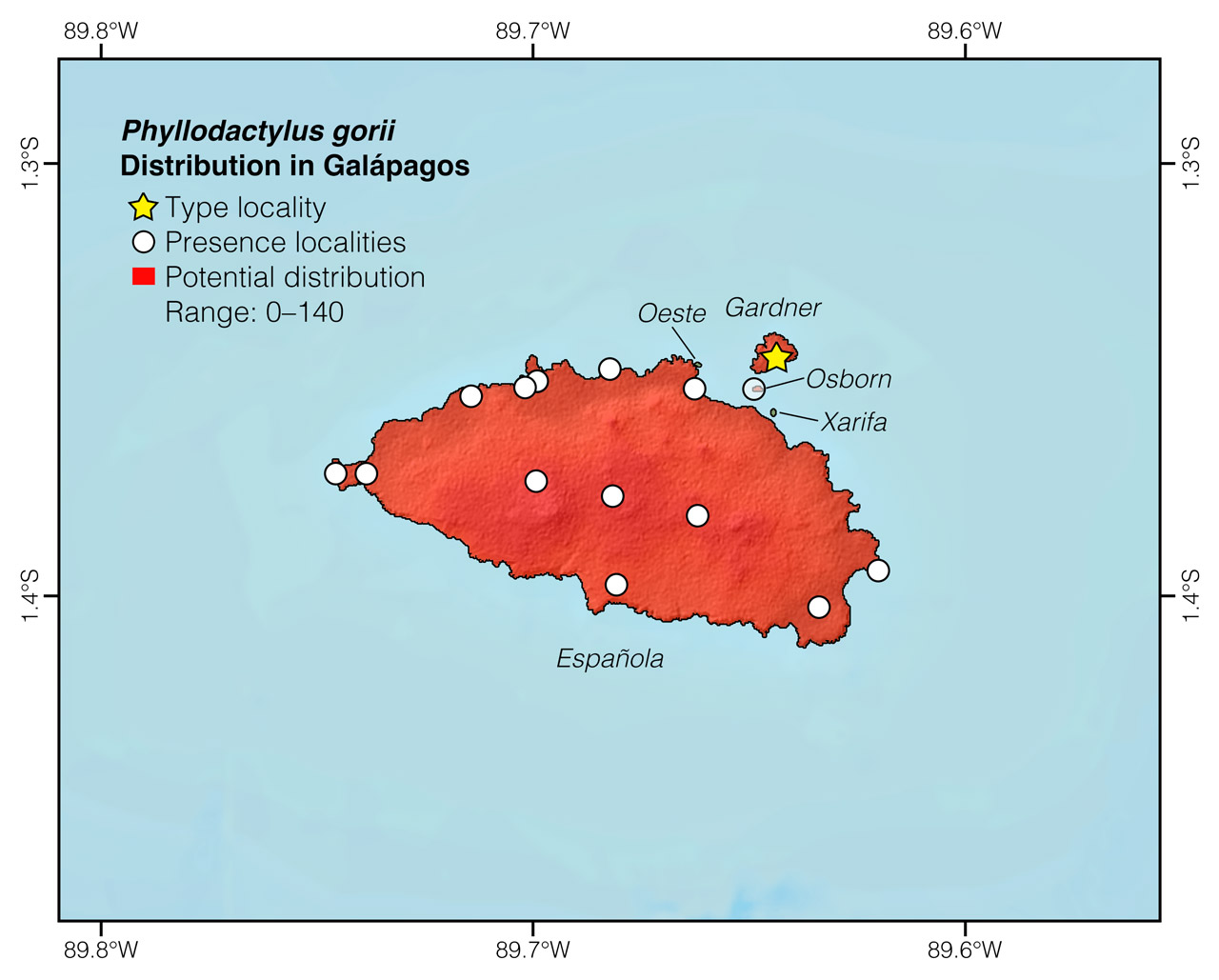Published October 10, 2019. Updated December 25, 2023. Open access. Peer-reviewed. | Purchase book ❯ |
Española Leaf-toed Gecko (Phyllodactylus gorii)
Reptiles of Ecuador | Sauria | Phyllodactylidae | Phyllodactylus gorii
English common names: Española Leaf-toed Gecko, Gori’s Leaf-toed Gecko.
Spanish common names: Geco de Española, salamanquesa de Gori.
Recognition: ♂♂ 8.9 cmMaximum distance from the snout to the tip of the tail. ♀♀ 8.4 cmMaximum distance from the snout to the tip of the tail..1 Phyllodactylus gorii is easily distinguishable from other native saurians occurring on Española Island (that is, iguanas and lava lizards) by its nocturnal habits, vertical pupils, and fingertips lacking visible claws.1 The dorsal coloration is usually pale grayish brown with broad irregular dark blotches and scattered white tubercles (Fig. 1).1 Phyllodactylus gorii is the only gecko known to occur in Española Island.1

Figure 1: Individuals of Phyllodactylus gorii from Gardner Bay, Galápagos, Ecuador. j=juvenile.
Natural history: Phyllodactylus gorii is a nocturnal and primarily terrestrial gecko that inhabits dry shrubland areas of Española Island. These geckos forage at ground level or on rocks, cacti, trunks, and branches up to 2 m above the ground.1,2 During daytime, they seek refuge under tree bark and lava blocks.1,2 When threatened, these shy reptiles flee into crevices, and, if captured, they may shed the tail. There are confirmed instances of predation on members of this species by mockingbirds.1 The eggs are laid under rocks.2
Conservation: Near Threatened Not currently at risk of extinction, but requires some level of management to maintain healthy populations..1 Phyllodactylus gorii is listed in this category because the species is, presumably, not undergoing population declines or facing major immediate threats of extinction. Española Island is not populated by humans nor exotic predators and is protected within the Galápagos National Park. However, since the entire population is restricted to a small island and its even smaller surrounding islets, the species is prone to be affected by random unpredictable events (like droughts and introduced species) within a short time period.1
Distribution: Phyllodactylus gorii is endemic to Española Island and two of its surrounding islets (Gardner and Osborn) in Galápagos, Ecuador (Fig. 2). Española is the southernmost of the Galápagos Islands and is also one of the oldest and flattest. It has an area of 60 km2 and a maximum elevation of 206 m (Fig. 3).

Figure 2: Distribution of Phyllodactylus gorii in Galápagos. See Appendix 1 for a complete list of the presence localities included in the map.

Figure 3: Distribution of Phyllodactylus gorii in Española Island. The star corresponds to the type locality: Gardner Islet. See Appendix 1 for a complete list of the presence localities included in the map.
Etymology: The generic name Phyllodactylus comes from the Greek words phyllon (=leaf) and daktylos (=finger),3 and refers to the leaf-shaped fingers characteristic of this group of geckos. The specific epithet gorii honors Luigi Gori, a Florentine engineer who led a scientific expedition to the Galápagos Islands in 1971–1972.4
See it in the wild: Since it is a nocturnal species, Phyllodactylus gorii is unlikely to be seen during touristic day trips to Española. Researchers and members of the Galápagos National Park may visit the island at night, but only in the context of a scientific expedition or a conservation agenda.
Authors: Alejandro Arteaga,aAffiliation: Fundación Khamai, Reserva Arlequín, Ecoruta Paseo del Quinde km 56, Santa Rosa de Mindo, Pichincha 171202, Ecuador. Gabriela Aguiar,bIndependent researcher, Quito, Ecuador. and Juan M GuayasamincAffiliation: Universidad San Francisco de Quito, Quito, Ecuador.
Academic reviewer: Cruz MárquezdAffiliation: University of Rome Tor Vergata, Rome, Italy.
Photographer: Jose VieiraeAffiliation: Tropical Herping (TH), Quito, Ecuador.,fAffiliation: ExSitu, Quito, Ecuador.
How to cite? Arteaga A, Aguiar G, Guayasamin JM (2023) Española Leaf-toed Gecko (Phyllodactylus gorii). In: Arteaga A, Bustamante L, Vieira J (Eds) Reptiles of Ecuador: Life in the middle of the world. Available from: www.reptilesofecuador.com. DOI: 10.47051/LKNW8543
Literature cited:
- Arteaga A, Bustamante L, Vieira J, Tapia W, Guayasamin JM (2019) Reptiles of the Galápagos: life on the Enchanted Islands. Tropical Herping, Quito, 208 pp. DOI: 10.47051/AQJU7348
- Van Denburgh J (1912) Expedition of the California Academy of Sciences to the Galápagos Islands, 1905-1906. VI. The geckos of the Galápagos Archipelago. Proceedings of the California Academy of Sciences 1: 405–430.
- Brown RW (1956) Composition of scientific words. Smithsonian Books, Washington, 882 pp.
- Lanza B (1973) On some Phyllodactylus from the Galápagos Islands (Reptilia Gekkonidae). Museo Zoologico dell’Università di Firenze, Florence, 34 pp.
Appendix 1: Locality data used to create the distribution map of Phyllodactylus gorii in Ecuador (Fig. 2). Go to the section on symbols and abbreviations for a list of acronyms used. Asterisk (*) indicates type locality.
| Country | Province | Locality | Source |
| Ecuador | Galápagos | Bahía Gardner | This work; Fig. 1 |
| Ecuador | Galápagos | Bahía Gardner, 3.5 km SW of | Arteaga et al. 2019 |
| Ecuador | Galápagos | Bahía Gardner, 4 km W of | Arteaga et al. 2019 |
| Ecuador | Galápagos | Gardner islet* | Lanza 1973 |
| Ecuador | Galápagos | Highlands of Española | Arteaga et al. 2019 |
| Ecuador | Galápagos | Osborn Islet | Lanza 1973 |
| Ecuador | Galápagos | Puerto Manzanillo | Torres-Carvajal et al. 2014 |
| Ecuador | Galápagos | Punta Cevallos | Torres-Carvajal et al. 2014 |
| Ecuador | Galápagos | Punta Cevallos, 1 km NW of | Arteaga et al. 2019 |
| Ecuador | Galápagos | Punta Suárez | Werner 1978 |
| Ecuador | Galápagos | Punta Suárez, 1 km E of | Arteaga et al. 2019 |
| Ecuador | Galápagos | Punta Suárez, 4 km NE of | iNaturalist; photo examined |
| Ecuador | Galápagos | Punta Suárez, 5 km E of | Arteaga et al. 2019 |
| Ecuador | Galápagos | Punta Suárez, 5 km NE of | iNaturalist; photo examined |
| Ecuador | Galápagos | South Central Española | Arteaga et al. 2019 |